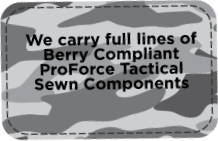Latest Posts
- Part 1 of 4 Series - Bow to Stern: Metal and Plastic Hardware Posted: 3/20/2019
- FR Treatments Explained Posted: 3/20/2019
- What is a DWR Treatment? Posted: 3/20/2019
- What Is Elastic and When Should You Use It? Posted: 3/20/2019
- Hook and Loop for Orthotics and Prosthetics Posted: 3/20/2019
Outdoor Fabric Testing for Manufacturers: Know how your textile will perform
Posted: 9/8/2016
By: Terri Shadrix

If you are a manufacturer using outdoor fabrics you need to know how your textile product will perform for your end-customer. Testing your raw materials and product prototypes can be a great way to find out.
This article will list the various testing methodologies used in testing of outdoor and industrial fabrics. The goal is to help the reader understand textile testing methods and if they apply to your product. In addition, readers should be aware and recognize the difference between standard and non-standard testing.
The 16 Common Industrial Fabric Tests:
- Colorfastness to washing –resistance of the material's color to fading or running after repeated washing
- Colorfastness to crocking –rubbing off of color from a fabric when subjected to abrasion.
- Colorfastness to water – resistance to water of dyed, printed, or otherwise colored textile yarns and fabrics
- Saliva & perspiration – resistance to the influences of saliva or sweat on colors
- Phenolic yellowing – a predictive test to assess the potential of white or pastel-coloured yarns, fabrics or garments to yellow
- Shrinkage – determines the dimensional changes of garments when subjected to home laundering procedures used by consumers
- Torque/Skewness – determines change in skewness in woven and knitted fabrics or twist in garments when subjected to repeated automatic laundering
- Seam strength – determine either the sewn seam strength of textiles or the efficiency of a seam assembly
- Yarn count – determine the yarn number and filament count of all types of yarns
- Thickness – measurement of the thickness of most textile materials
- Fabric weight – there are four accepted methods for measurement of fabric mass per unit area (weight) applicable to most fabrics
- Water repellency – measure resistance of fabrics (or garments) to wetting by water
- Adhesion – testing adhesion of coating to fabric and breaking strength after crease fold
- Tension strength – determination of breaking force and elongation of most woven or nonwoven textile fabrics
- Color difference analysis – the calculation, from instrumentally measured color coordinates based on daylight illumination, of color tolerances and small color differences between textile swatches
- Salt spray test – resistance of a material to a variety of saline and non-saline environments indicative of the reaction to other corrosive conditions
It’s always good to have resources for your textile testing questions, so we’re letting you know DirecTex can help.
Learn More About.DirecTex Material Testing Lab.




